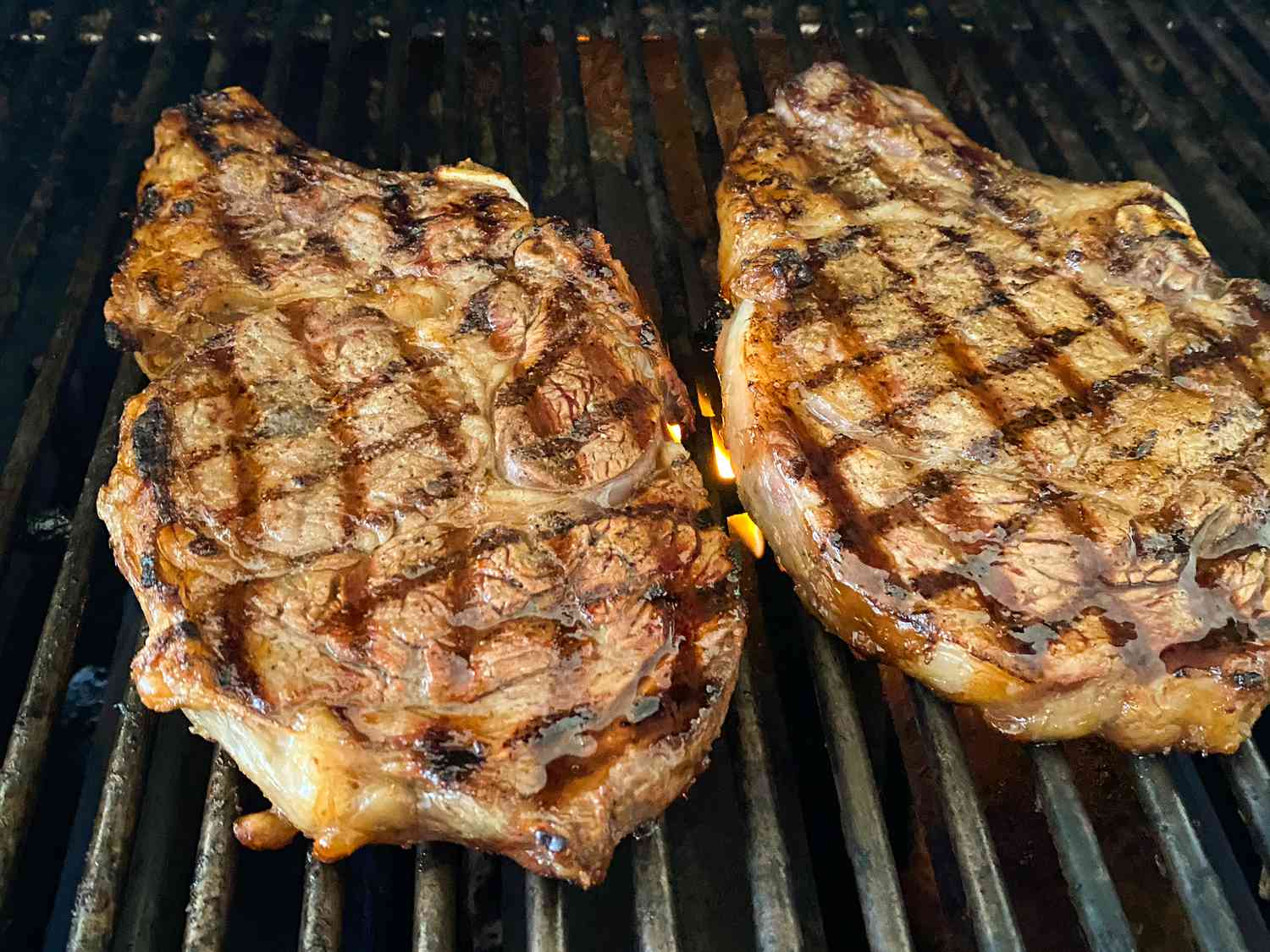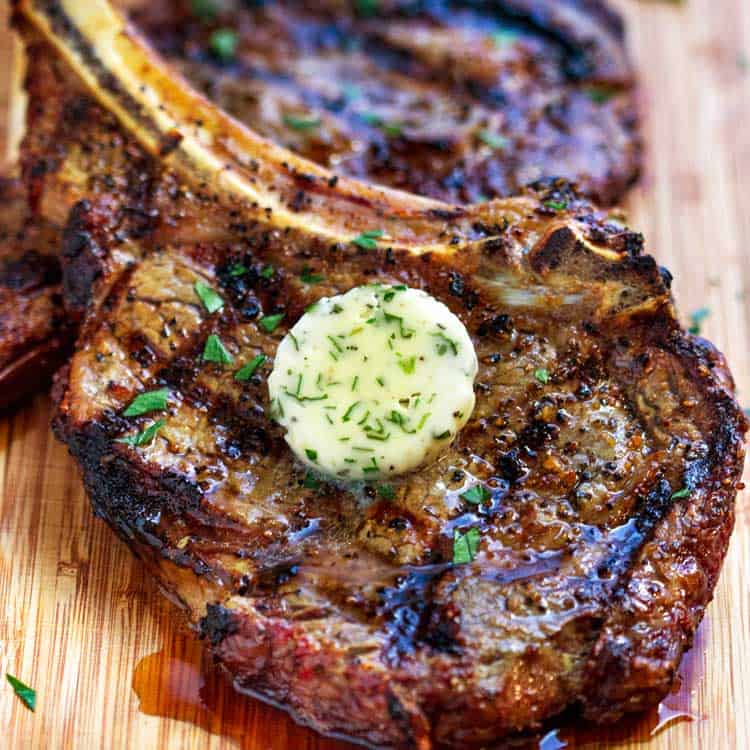-
Ribeye steak, a prized cut from the cow’s rib section, is famous for its rich marbling, intense flavor, and melt-in-your-mouth tenderness. But grilling it correctly can elevate this flavorful cut to an entirely new level. This guide delves into everything you need to know about grilling ribeye steak to perfection, ensuring you achieve the desired level of doneness while preserving its inherent juiciness and tenderness.
Understanding Ribeye Steak:
Ribeye, also known as delmonico or prime rib, comes in various cuts. The standard cut is 1-2 inches thick, while the petite ribeye is ideal for quick grilling. Bone-in cowboy ribeye offers a more rustic grilling experience. Regardless of the cut, ribeye boasts a bold, beefy taste with hints of iron and blood. Its abundant marbling contributes to exceptional juiciness and tenderness – a true culinary delight when cooked just right.

-
The Importance of Proper Grilling:
Grilling ribeye steak correctly goes beyond simply throwing it on the grill. Here’s why mastering the technique matters:
-
Achieving the Perfect Doneness: Ribeye shines when cooked medium-rare or medium. Overcooking leads to dryness and toughness, detracting from its inherent qualities.
-
Preventing Dryness: While marbling helps retain moisture, overcooking can still dry out the steak. Proper grilling ensures a tender and juicy result.
-
Enhancing Tenderness and Flavor: Quick searing and resting techniques help break down muscle fibers, making the steak even more tender and flavorful.
Factors Affecting Cooking Time:
Several factors influence how long to cook your ribeye steak:
- Thickness: Thinner steaks cook faster than thicker ones.
- Doneness Level: Rarer steaks require less cooking time than well-done ones.
- Grilling Method: Higher temperatures and direct heat cook faster than lower temperatures and indirect heat.

Understanding Levels of Doneness:
The ideal level of doneness is a matter of personal preference. Here’s a breakdown to help you decide:
- Rare (120-125°F): Red throughout with a slightly warm center.
- Medium-Rare (130-135°F): Slightly pink in the center with a warm red outer edge.
- Medium (140-145°F): Slightly rosy in the center with a cooked outer edge.
- Medium-Well (150-155°F): Mostly cooked with a hint of pink in the center.
- Well-Done (160°F and above): Fully cooked throughout with no pink remaining.
Recommended Cooking Times:
Keep in mind that these are guidelines, and you may need to adjust slightly based on your specific circumstances.
-
1-inch thick ribeye steak:
- Rare: 4-5 minutes per side
- Medium-Rare: 5-6 minutes per side
- Medium: 6-7 minutes per side
- Medium-Well: 7-8 minutes per side
- Well-Done: 8-10 minutes per side
-
1.5-inch thick ribeye steak:
- Rare: 5-6 minutes per side
- Medium-Rare: 6-7 minutes per side
- Medium: 7-8 minutes per side
- Medium-Well: 8-9 minutes per side
- Well-Done: 9-11 minutes per side
-
2-inch thick ribeye steak:
- Rare: 6-7 minutes per side
- Medium-Rare: 7-8 minutes per side
- Medium: 8-9 minutes per side
- Medium-Well: 9-10 minutes per side
- Well-Done: 10-12 minutes per side

Tips for Grilling Perfection:
-
Selecting the Right Steak: Choose a steak with good marbling for added flavor and tenderness. Trim excess fat, but leave a thin layer for additional flavor.
-
Preparing the Steak: Bring the steak to room temperature before grilling for even cooking. Pat it dry with paper towels to ensure a good sear.
-
Seasoning for Success: Season generously with salt and pepper on both sides just before grilling for maximum flavor penetration. Experiment with garlic powder, onion powder, or a steak rub for a customized flavor profile.
-
Grilling to Perfection: Preheat your grill to high heat (400°F-450°F) for optimal searing. Grill the steak for the desired amount of time per side, using a stopwatch for precise timing. Avoid piercing the steak with a fork, as this releases juices and dries it out. Use tongs to maneuver the steak.
-
-
Resting for Maximum Flavor: After removing the steak from the grill, transfer it to a plate and let it rest for 5-10 minutes before slicing. This allows the juices to redistribute throughout the steak, resulting in a more tender and flavorful experience.

Additional Tips for Grilling Champions:
-
Marinating Magic: While marinating for 30 minutes to an hour can enhance flavor and tenderness, it won’t significantly impact cooking times. Use a simple marinade of olive oil, soy sauce, garlic, and herbs for added depth.
-
Searing for a Crust: For a beautiful caramelized crust, sear the steak for 30-60 seconds per side over high heat. Minimize movement during searing to achieve that irresistible exterior.
-
Thermometer for Accuracy: A meat thermometer is the most reliable way to determine doneness. Insert it into the thickest part of the steak, avoiding bone or gristle, and refer to the internal temperature guide above for your desired level.
Slicing and Serving:
-
Slicing Against the Grain: To ensure tenderness, slice the ribeye steak against the grain. This means cutting across the muscle fibers, making them shorter and easier to chew.
-
Serving Suggestions: Grilled ribeye steak pairs beautifully with various sides. Here are a few ideas:
- Grilled vegetables
- Roasted potatoes
- Chimichurri sauce (a zesty Argentinian condiment made with parsley, olive oil, garlic, and vinegar)
- A simple green salad

Conclusion A:
Grilling ribeye steak can truly be a rewarding experience, offering you the opportunity to indulge in a succulent and flavor-packed cut of beef. With its marbling and tenderness, the ribeye steak is lauded for its exceptional taste and juiciness. By following the expert tips and techniques outlined below, you can elevate your grilling game and create a showstopping dish that will dazzle your taste buds and impress your guests at your next barbecue.
First, preparation is key. Take the time to properly season your ribeye steak with a combination of salt, pepper, and any additional desired spices or herbs. Allow the steak to come to room temperature before grilling, ensuring even cooking throughout. This step helps to enhance the flavors and ensures a deliciously seasoned crust upon grilling.
Next, understanding the factors that affect cooking time is crucial. The thickness of your ribeye steak plays a significant role in determining the cooking duration. Thicker cuts will require more time on the grill to achieve the desired doneness while thinner cuts will cook more quickly. Additionally, the heat of your grill and the level of doneness you prefer will also influence the cooking time. By keeping these factors in mind, you can achieve the perfect level of doneness that suits your preferences.
Part B:
Fire up the grill and get ready to embrace the techniques that will help you achieve a perfectly grilled ribeye steak. Start by preheating your grill to high heat to create those coveted grill marks and a beautiful sear. Ensure that the grates are clean and well-oiled to prevent the steak from sticking.
Once your grill is properly preheated, carefully place the seasoned ribeye steak onto the hot grates. Allow it to sear for a few minutes on each side, resisting the urge to constantly flip the steak. This initial sear locks in the juices and imparts a delicious caramelized crust.
To achieve the desired level of doneness, use a meat thermometer to monitor the internal temperature of the steak. For a rare steak, aim for an internal temperature around 120°F (49°C), medium-rare around 130°F (54°C), medium around 140°F (60°C), and medium-well around 150°F (66°C). As each grill may vary, it’s important to rely on the temperature readings rather than strict time guidelines.